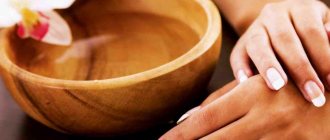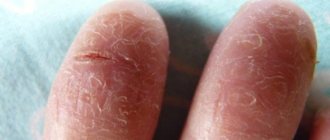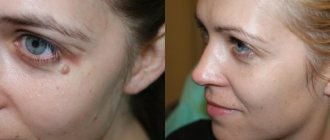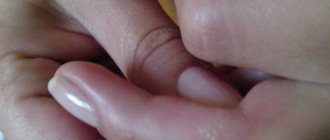Many dermatologist patients complain of quickly, within a few days, keratinization of the skin on their fingers. Since in the first period of the disease most people try to eliminate this defect on their own, using warm baths and rich creams, they see a doctor only when deep, painful cracks form on the skin. Hyperkeratosis is a general name for a whole group of diseases that cause this symptom, some of them are very serious. This disease is characterized by disruption of the epidermis, an increase in the layer of dead cells and the formation of areas covered with the stratum corneum.
Causes of hyperkeratosis
Excessive proliferation of skin surface cells has many causes, both mechanical and pathological. Rough skin on the fingers is often observed in people whose professions involve daily pressure on these areas, for example, shoemakers or guitarists. The areas of skin that come into contact with the strings become horny, forming a layer of cells and protecting the skin. Workers who constantly deal with resins, sand or tar suffer from excessive cell growth on the fingers and palms, and this is dangerous because the degeneration of such cells can cause a malignant skin disease.
Age-related changes in hormonal levels entail keratoderma: during menopause, some women develop skin layers on the palms and fingers, they are diffusely located and have a grayish or yellowish color. Sometimes keratinization becomes covered with deep, painful cracks. Senile lumps and plaques on the hands usually do not bother their owners, but there is a risk of such cells degenerating into cancer.
Horny skin on the fingers of children and adolescents is a symptom of a serious illness, so keratoderma is most often caused by a gene mutation. Provoking factors can be various viral diseases, hormonal imbalances, a lack of vitamin A in the body, and the cause of the deficiency can be both external and internal. Poor nutrition and diseases of the digestive system, cancer and metabolic disorders are the main reasons for incomplete absorption of vitamin A, which in turn provokes keratosis.
The cause of the proliferation of epithelial cells is sometimes an allergic reaction to a cosmetic product or washing powder. Excessive consumption of food allergens also causes the appearance of horny layers of cells.
In addition to these, there are other causes of dry hand skin:
- avitaminosis;
- lack of care for delicate skin;
- use of cosmetics with irritating ingredients (alcohols, oils, scrubs, preservatives, etc.);
- non-compliance with the balance of nutrients and minerals;
- some medications (diuretics, laxatives, etc.);
- dry indoor air (radiators, air conditioners, heaters);
- untreated chlorinated water (at home, in swimming pools);
- smoking;
- constant stress;
- insufficient amount of fluid drunk per day;
- diabetes;
- disorders of the thyroid gland;
- psoriasis.
Individual consultation
Symptoms of keratosis
First of all, a patient with keratoderma notices that he has rough skin on his fingers, and skin softening products do not bring the expected result. Then, after a sufficiently long period of time, the layer of cells becomes thick, the tissue underneath dies, and the edges of the stratum corneum acquire a purple tint. In the thickening itself, deep, painful, bleeding cracks form, the nails become lumpy and irregular in shape.
The symptoms of occupational or mechanical keratosis, which is the body’s response to local skin irritation, are much less pronounced. Constant pressure on the fingertips leads to the formation of calluses, and then the skin becomes coarser, the surface cells of the epidermis die off and do not slough off, as a result of which keratinization occurs. Occupational keratosis can also be accompanied by the formation of cracks in the stratum corneum, but it is limited only to those areas of the skin that are periodically injured, without spreading further.
Follicular keratosis most often forms on the flexor surfaces of the extremities, but can also be localized on the hands. The patient notices that the skin on his hands is pimply and tough. Follicular keratosis, apart from a cosmetic disadvantage, does not annoy the patient, but can spread throughout the body. One of the reasons for the occurrence of this form of the disease is heredity: according to statistics, people whose parents had a history of keratosis pilaris are most likely to develop it between the ages of fifteen and twenty-five.
Center for Aesthetic Cosmetology "SM-Cosmetology" - a place where they will help you
Our Center employs experienced specialists of various profiles - cosmetologists, nutritionists, dermatologists, gastroenterologists, endocrinologists, etc. They will not only help soften the skin of your hands, but will also identify the causative factor of this condition.
The examination at the clinic is carried out comprehensively and individually, taking into account all possible characteristics of the body and past diseases. This approach allows you to choose the optimal treatment and procedures.
Among the methods that guarantee softening and rejuvenation of the skin of the hands in SM-Cosmetology:
- endermolift LPG;
- ultrasonic cleaning;
- microcurrent therapy;
- Starvac massage;
- spa treatments;
- RF lifting;
- ZEIN OBAGI (therapeutic cosmetics);
- various hand skin care products.
Call us and we will answer all your questions in detail!
—>
Treatment of keratoses
Keratoses associated with the professional activities of patients with exposure to toxic substances, such as arsenic or tar, are difficult to treat until the person stops engaging in this type of activity. The disease can last for years and go away completely on its own when the employee quits or changes profession.
At the first signs of causeless coarsening of the skin on your fingers, you need to carefully adjust your diet, add vitamin complexes and an oil solution of vitamin A. Locally, thoroughly clean the skin on your hands every evening, lubricate the rough areas with a nourishing cream with the addition of vitamin A. A good result is achieved by using gloves Spa Belle, they moisturize the skin, have a soft and gentle effect, releasing softening and beneficial components of the gel impregnation. You can buy silicone gloves in the online store.
If the symptoms of keratosis are severe enough, you should consult a doctor for a full examination and identify the cause of the disease. It is possible that keratinization of the skin is caused by some disease, and its treatment will help eliminate the unpleasant symptom. Ointments and creams containing healing and softening components are used locally.
At any stage of the development of the disease during the inflammatory process, it is advisable to use ointments containing antibiotics and steroids. They are used in short courses to relieve inflammation, and then use wound-healing drugs such as Panthenol or Solcoseryl, which enhance tissue regeneration. Baths with astringent herbal decoctions and compresses with plantain or aloe juice are also quite effective in the symptomatic treatment of keratoses.
Unique treatment methods at the Innovative Vascular Center
The specialists of our clinic have unique methods of microsurgical restoration of blood circulation in case of gangrene of the hand or critical ischemia. In the treatment of such pathology, we profess the principle of sufficiency of revascularization and accurate identification of the causes of the development of pathology. Sometimes restoring blood flow by removing a blood clot or bypass surgery alone is not possible. A common cause of gangrene in the arm is compression or damage to the arteries of the shoulder girdle. When such a pathology is identified, we intervene at this level. Our surgeons have extensive experience in performing operations for ischemia and gangrene of the upper limb - they have operated on more than 100 patients with similar pathologies.
Prevention of keratosis
The main treatment for keratosis of any etiology is to prevent the development of the disease. But since it is not known for certain what triggers the onset of the disease, you just need to maintain general hygiene, not subject your hands to excessive stress, and take good care of them. Sagging skin on the hands, calluses and redness are a signal for immediate action: stopping any diet, taking vitamins A and E, and cosmetic procedures.
People whose professions involve the development of this disease, or who have had cases of this disease in their family, are advised to closely monitor their health, since keratosis, although it does not threaten human life, sometimes makes it unbearable. Horny skin reduces the sensitivity of the hands, interferes with delicate work, and cracks make any movement impossible due to extreme pain. The duration and, sometimes, failure of treatment for horny growths is a reason to think about preventive measures for an unpleasant disease.
How to eat healthy
The most important reason why the epidermis dries and cracks is a lack of vitamins, which results in the development of vitamin deficiency. If the body lacks fat-soluble vitamins E or A, the condition quickly worsens. What you need to eat so that these vitamins are not deficient:
- Vegetable products: tomatoes, carrots and sweet peppers, beans.
- Meat products: liver, beef and veal.
- Dairy products: fermented milk products (kefir, fermented baked milk), cottage cheese.
- Oils: any vegetable.
Nuts of any kind saturate the body well with the necessary vitamins. Saturating the body with the required amount of necessary elements will help the rapid restoration of the dermis.
To achieve a good effect, you need to give up foods: alcohol, spices, fatty meats, baked goods, sweets, sausages and canned foods.
Hand hygiene
How to treat and how to prevent changes in the skin of the hands depends to a certain extent on hygiene. The following manipulations should be performed regularly to keep the skin in order:
- It is required to come into contact with water and chemical compounds as little as possible. Stop wearing nail polish. Always wear silicone gloves when washing dishes or cleaning the house.
- Every evening, apply a rich cream with glycerin to your brushes. To enhance the effect, you can then put on cotton gloves.
- To wash your hands, use soft, less aggressive soaps, such as “baby” and “bath” soaps.
- You need to take herbal baths often. When the procedure is over, you should lubricate your hands with a rich cream, for example, “Children’s”.
- In severe cases, when the dermis is thoroughly cracked and the wounds do not heal well, you can use special medical glue. It is necessary to lubricate the cracks with this substance - this will help the wounds heal. The product is sold in pharmacies and is called “Super-Glu”.
When there is nothing serious with your health, these procedures should help and completely heal dry skin. If this does not help, you need to resort to drug therapy.
Drug treatment
Cracks with blood oozing do not appear immediately. First, the epidermis dries out, then begins to peel off. Then microcracks appear in this place, they gradually deepen, begin to itch and bleed. If a bacterial infection gets into the wound, the crack site becomes inflamed and fester occurs.
Cracks appear on the fingertips, the skin becomes rough and raised, which is why the rupture occurs with pain. The epidermis in the interdigital area is very delicate; if you work without protection with chlorinated water and chemical components, then a burning sensation begins in these places, and then rupture. Deep and large breaks occur around the nails. They prevent a person from living and working normally. Therefore, it is important to start treating this problem in a timely manner.
Drug therapy consists of topical application of ointments and creams, and taking medications in the form of capsules and tablets. It is imperative to carry out comprehensive treatment, since ointments alone cannot cure the problem.
Hand treatment should be carried out more than once a day. The most effective drugs for improving skin condition are:
- Depanthenol and Bepanten. These are ointments with active elements such as vitamin B and chlorhexidine. Vitamins increase the healing of cracks, and chlorhexidine kills pathogenic microflora well. It is necessary to treat wounds three times a day, making a thin layer on the skin.
- Radevit. An ointment containing vitamins A, E, D. The composition makes the skin softer, tightens wounds and relieves inflammation. Strengthens the protective properties of the epidermis and regulates the processes of cell keratinization. It is recommended to apply the ointment in the morning and evening.
- Pantoderm. The ointment accelerates metabolic processes and restores dermal cells. It has a beneficial effect on the regeneration process of the skin of the hands. It is acceptable to lubricate problem areas more than once a day.
- Eplan. The ointment has excellent protective functions, forming a thin and invisible film on the surface and does not allow pathogenic microorganisms to enter the wounds. Relieves itching, which bothers you when wounds heal, and accelerates their healing. Handles should be treated twice a day: in the morning and after lunch.
- Aevit. Doctors prescribe capsules if there is a lack of vitamins A and E. The drug should be taken one capsule per day. The duration of treatment is from 20 to 40 days.
- Apilak. Ointment with propolis. Quickly tightens wounds and cures dry skin.
- The power of the forest. Cream containing Floralizin. Made from natural raw materials and rich in vitamins A, D, E, natural active ingredients with fatty acids, antioxidants and amino acids. It saturates the epidermis well with moisture and helps quickly heal cracks.
- Boro-Plus is purple. This is an ointment made from decoctions of several medicinal herbs. Apply to the affected areas twice a day until the cracks disappear.
- Hydrogen peroxide. Before applying medicinal ointments, it is necessary to treat the affected areas with this solution, applying it to a cotton swab and blotting the cracked surface.
- Levomekol. The ointment is used to eliminate pathogenic bacteria from the surface of the affected dermis. Treat sore hands twice a day.
- Prednisolone. This is a hormonal ointment, used if other remedies have not helped. The cracked dermis should be lubricated three times a day, but no more than 5 days in a row.
- Exoderil. The ointment is used for fungal infections. Penetrates deeply into the epidermis; it should be applied specifically to the affected areas twice a day until complete recovery.
All medications must be prescribed by the attending physician. Any medicine has side effects, so you should not risk your health, but rather follow all the doctor’s recommendations.
Treatment with traditional medicine
If the skin on your fingers dries out and cracks appear, traditional medicine recipes can be a good way to cure the problem. The use of hand baths and masks is suggested here. It must be said that they are effective against damage to the epidermis due to exposure to external factors. But they can be used in combination with drug therapy to relieve unpleasant symptoms. The most popular folk remedies are the following procedures:
- Melt some natural beeswax in a water bath. Dip the tips of the affected fingers into hot wax so that you can endure it. Let the wax harden and put cotton gloves on your hands. You should keep your brushes in gloves for at least 12 hours, so it is better to do this procedure at night. Use the recipe every day until complete recovery.
- Baths made of milk and glycerin. Mix the liquids and heat them in a warm mixture, hold your hands for 10-15 minutes and do them several times a day.
- Make a decoction from a collection of herbs: coltsfoot, flowers and leaves of linden, meadowsweet and plantain, mixing them in equal quantities. Before you put your hands in the broth, you need to pour a little olive oil into it.
- Potato mask. Grate raw potatoes on a fine grater to make a paste, pour a spoonful of honey into it. Mix everything and coat your cracked fingers. Then put on rubber gloves on your hands and cotton gloves on top. It is recommended to keep the brushes in the mask for 10-60 minutes, depending on the severity of the condition. It is better to wash off the mask with a warm herbal decoction.
- Egg mask. Mix the yolk with a spoon of honey and vegetable oil. The mask should not be too thick. Treat the skin and hold as described in the previous paragraph.
- Honey. Mix 3 tablespoons of honey with a teaspoon of olive or sea buckthorn oil, apply the mask to the affected areas.
- Salt bath. Dissolve 3 tablespoons of iodized salt in 250 ml of warm water and drop tea tree oil into it. Keep the brushes in it for 15-20 minutes, then rinse with warm water, wipe dry and lubricate the surfaces to be treated with a softening cream.
- Herbal bath. Take 2 spoons of plantain, calendula and chamomile herbs, brew the mixture with a liter of boiling water. Let the infusion cool and place your hands in the warm broth for 20 minutes. After all, treat the skin with a moisturizer.
Treatment with baths and masks should begin as soon as flaky skin is detected. If deep cracks appear, then drug treatment prescribed by the doctor will help.











